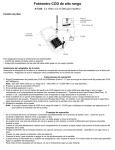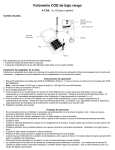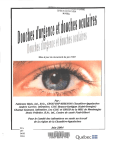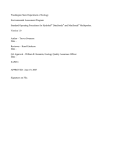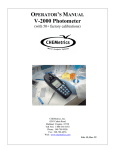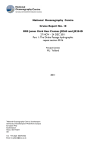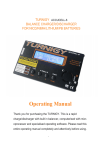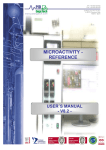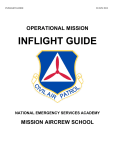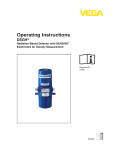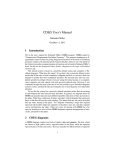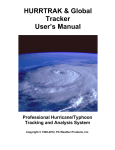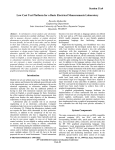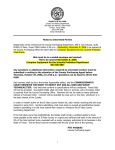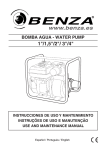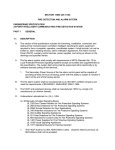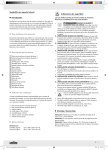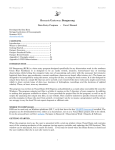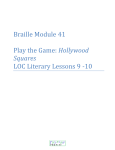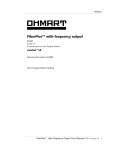Download chapter 7 maintenance considerations to ensure data quality
Transcript
CHAPTER 7 MAINTENANCE CONSIDERATIONS TO ENSURE DATA QUALITY 7.1 INTRODUCTION To ensure good quality data during a water quality monitoring project a maintenance program must be in place for the monitoring sondes, platforms and equipment employed. There are three basic types of maintenance procedures (U.S. Department of Energy): • Reactive or corrective maintenance is an unscheduled action performed on a system, equipment or one of its components in the attempt to restore it to a specified performance condition. Basically, the system or product is fixed once it brakes down or fails to perform as desired. • Preventive maintenance is a scheduled action performed on a system, equipment or one of its components to detect or mitigate performance problems, degradations, functional or potential failures, etc. with the goal of maintaining the systems’ or product’s performance and it’s level of reliability. • Predictive maintenance is the action performed on a system, equipment or one of its components to determine their performance and act in accordance of the results. For example, instead of changing the oil in the car every X miles (preventive), the oil is analyzed to determine its performance and depending on the results, the oil will be kept or changed. Thus the oil can be changed before the X miles or kept for extra miles. The need for maintenance is determined by the condition of the system, equipment or component analyzed. Even though, it is most probable that in a water quality monitoring endeavor all three of these types of maintenance procedures are going to be applied, the maintenance program must be focused on preventive and predictive maintenance. To implement a successful maintenance program, the following three areas must be covered: a) Training: the personnel that perform maintenance activities (e.g. calibration and post calibration of monitoring sensors, equipment and station inspections, cleaning and replacement of instruments or parts) must have the adequate training to ensure that they possess the necessary competence to do an effective and efficient job. b) Procedures and record management: procedures and record management must be in place to ensure that (among other things): → The maintenance activities are well documented. → All instruments calibrated will conform to required specifications. → The operation and control of the processes are effective. → Methodologies to assess the root cause of problem are known. → Maintenance schedules are established. → Maintenance records are well kept and easily accessed and traceable. → Evidence of conformity of calibration is provided. 148 c ) Procurement and spare parts management: to ensure the reliability of the c) monitoring endeavor, each monitoring equipment or system must have an adequate spare parts procedure to guarantee the availability of resources. There are three main hardware systems that need to be addressed in a water quality monitoring maintenance program: → Monitoring sondes → Monitoring stations → Verification equipment When addressing the maintenance program of these systems, it is important to consider that: → Not all equipment or components have equal importance and equal impact on data quality. → The probability of failure or mal-function is different between equipment, parts, and structures. → Service or maintenance cycles differ between equipment. → There is limited financial and personnel resources. NOTE: To assure data quality, a quality assurance/control & maintenance program for the monitoring data must be in place. To obtain guidelines on how to approach this issue, the reader should consult EPA QA/G-5, EPA QA/G-8 and Helsel and Hirsch (2002). 7.2 SONDE MAINTENANCE Data quality is directly related to the monitoring sonde performance. Therefore, it is crucial to have a sonde maintenance program. In general, the maintenance program would be based on “maintenance cycles” correlated to the time frame the sondes can stay deployed without affecting data quality. The cycle will depend on the probes’ characteristics, environmental conditions (i.e. high fouling environments), battery life, and any other factors that affect the sonde’s performance. In most monitoring situations the maintenance cycles follow a seasonal pattern. For example, in high fouling environments, the length of time the sonde can remain deployed will decrease as water temperature increases; monitoring sondes that can be deployed for three weeks to one month in winter may need to be changed on a weekly basis in summer. 149 The sonde maintenance program must address at least the following procedures: Î Prepare the sonde for deployment Î Calibration for deployment Î Post-deployment performance verification 7.2.1 PREPARE THE SONDE FOR DEPLOYMENT The sonde must be adequately prepared to handle the environmental factors that could influence data quality. These physical, biological, and chemical factors are characteristic of the monitoring site location. Therefore, no unique solution exists to address these factors and the best approach to control them will have to take into account, not only the site characteristics, but also, the deployment cycle and the design of the monitoring station. Among the environmental factors, special attention must be given to biofouling given that is one of the main factors affecting the operation, maintenance and data quality of the sondes (some examples of common and extreme biofouling are displayed in Figure 7.1). Among the many methods employed to reduce or prevent biofouling, the most common ones are: • • • • • • Painting the housing of the sensors with antifouling coatings. Covering the housing of the sensors with antifouling copper tape. Using the adequate anti-fouling probes’ wiper/wipers. Painting the entire wiper body, including the undersides with anti-fouling paint. Using sensors with copper alloy housings. Using copper-alloy sonde guard or painting the sensor guard with anti-fouling coatings (do not Figure 7.1 Copper tape on guard paint the threads). and probes NOTE: → Black anti-fouling paint is strongly recommended. The black color will eliminate any chance of stray reflection from the infrared light source when the probe is making measurements (YSI, 2009). → Painting the body of the instrument is not recommended. Instead of using paint, the body can be wrapped with plastic wrap and secure with duck tape or with plastic electrical tape. → In addition to the use of anti-fouling paint or copper product, during long-term deployments in extreme fouling environments, the deployment cycle must be adjusted to the appropriate length to ensure data integrity. 150 Figure 7.2 Biofouling examples (Source: CBNERRVA, NIW - NERR, CICORE) 151 7.2.2 CALIBRATION FOR DEPLOYMENT It is crucial that all sensors are calibrated following strictly the manufacturer’s calibration procedures. Therefore, management must assure that: • Laboratory personnel have the necessary competence for the effective and efficient application of the calibration procedures. • Systems are in place to assure sensor’s performance verification. • Records are kept to provide evidence that the requirements have being met. Two examples of calibration logs are presented in Figure 7.3 and 7.4. • Critical parts, components and chemicals are in stock to ensure proper maintenance activities. NOTE: → Many multiparameter sondes are equipped with depth sensors that measure water depth using a differential strain gauge transducer with one side of the transducer exposed to water and the other to a vacuum. The transducer measures the pressure of the water column plus the atmospheric pressure (YSI, 2008). During calibration, the depth is calibrated in air and a depth offset must be used if the pressure is different than 760 mm Hg. To determine the correct depth offset, record the barometric pressure at the time of calibration from a meteorological station at the calibration site or a reliable local station. Tables 7.1 to 7.3 show offset correction as a function of atmospheric pressure. These tables can be use to determine the offset to use during calibration (CDMO, 2207). → When using a plastic or copper screen (or copper tape) at the bottom of the sensor guard there is a possibility that interference with turbidity readings could result from the screen. To cancel any affects it might have, it is necessary to calibrate the turbidity probe (1 point) in the zero standard with the deployment sensor guard installed. The amount of offset is generally determined by the reflectivity of the guard and screen. In case of using plastic screens, it is a good practice to use black screens or paint the screen with black antifouling paint. For copper screens, once the copper has taken on the patina color the amount of offset decreases. Another option would be to soak the parts in salt water to patina them before your calibration (Source: NIW Bay NERR) If copper tape is used and replaced every deployment, then new offset must be determined every time the guard is re-taped. 152 Table 7.1 Depth Offset (mm Hg) (Source: CDMO, 2207) 153 Table 7.2 Depth Offset (mb) (Source: CDMO, 2207) 154 Table 7.3 Depth Offset (in Hg) (Source: CDMO, 2207) 155 Figure 7.3 NERRS 6-series calibration log 156 HYDROLAB MULTIPROBE CALIBRATION/MAINTENANCE LOG Calibration ____ Post Calibration ____ Initials: Date: Time: Instrument: Battery Voltage: If this is a post calibration, give date of original calibration ______ Temp. of Standard Function Value of Standard Initial Reading Calibrated to Comments Specific conductance pH calibrated (~7) pH slope (~ 4/10) Dissolved oxygen DATA NEEDED FOR DISSOLVED OXYGEN CALIBRATION Altitude (A )=______________feet above msl Barometric pressure _________ inches Barometric Pressure (BP) Options Barometric Pressure Formulas Barometer Barometric pressure (inches) ________ x 25.4 = BP ________mm From local source after correction (CBP) BP _________ mm = CBP _______mm - 2.5 (altitude ____/100) Estimated from altitude only BP _________ mm= 760 mm - 2.5 (altitude _____/100) For older Hydrolabs: Table DO value______ x ALTCORR______ x BAROCORR ______= DO standard _______ Calibration ____ Post Calibration ____ Initials: Date: Time: Instrument: Battery Voltage: If this is a post calibration, give date of original calibration ______ Temp. of Standard Function Value of Standard Initial Reading Calibrated to Comments Specific conductance pH calibrated (~7) pH slope (~ 4/10) Dissolved oxygen DATA NEEDED FOR DISSOLVED OXYGEN POST CALIBRATION Barometric Pressure (BP) Options Barometric Pressure Formulas Barometer Barometric pressure (inches) ________ x 25.4 = BP ________mm From local source after correction (CBP) BP _________ mm = CBP _______mm - 2.5 (altitude ____/100) Estimated from altitude only BP _________ mm= 760 mm - 2.5 (altitude _____/100) For older Hydrolabs: Table DO value______ x ALTCORR______ x BAROCORR ______= DO standard _______ Check previous maintenance and use; do the following before calibration: Polish conductivity electrodes. Must be polished within the last two months or once every 15 field trips Date: Name/comments: Change pH reference probe solution. Must be renewed within last two months or once every 15 field trips. Date: Name/comments: Inspect DO membrane for nicks or bubbles. Must be changed within last six months or once every 15 field trips. Date: Name/comments: Change battery in 400 series sonde. Change once a year. Change internal batteries for newer generation products according to guidelines in product manual. Date: Name/comments: Figure 7.4 Multiprobe calibration log (Source: Texas Commission on Environmental Quality, 2003) 157 7.2.3 POST-DEPLOYMENT PERFORMANCE VERIFICATION Sonde post-deployment performance verification should include: post-calibration or field performance assessment and field verification activities. Post-calibration: activity done in a controlled laboratory environment after retrieval of the monitoring sensor. The sensor readings are compared to standard solutions to determine its performance. On-site post-calibration can be performed following the same procedures as laboratory calibrations. Field performance assessment: activity conducted in the field. As soon as the sensor is retrieved it is placed in a standard solution and readings are recorded. Field verification: indirect measurements of sonde performance. Using fieldmeasuring equipment, water quality measurements are taken and compared to sonde readings. Probe performance records are used for continual improvement, data analysis and nonconformity management. As an example, a post-calibration log is presented in Figure 7.5. 158 Figure 7.5 YSI 6-series post-calibration log 159 During field verification, it is a good practice to take an independent measurement for each sensor parameter. Generally, field verification is performed during the monitoring sonde exchange phase. A possible sonde switch-out process could be: 160 For on stream & river bank platforms, a different method to obtain simultaneous readings between the replacement sonde and deployed sonde must be used if the station has only one guard-pipe. Possible reasons for using only one guard-pipe are: → → The guard-pipe is placed where there is a small pooling of water or the sampling area is not big enough to accommodate two sondes. Due to high flow conditions, cost or maintenance issues it was decided to put only one guard-pipe. If only one guard-pipe is used, a possible switch-out process could be: 161 For monitoring stations with telemetry capabilities, the following procedure is recommended to interchange the field cable connector between the deployed and the replacement sonde. 162 WATER QUALITY MONITORING DEPLOYMENT AND RETRIEVAL LOG Identification Number Revision Effective Date Pages Page 1 of 1 Field Location Crew DATALOGGER INFORMATION YSI ID Number Time (EST) Deployment (in) Retrieval (out) WEATHER INFORMATION Weather Conditions measured with Kestrel Wind Speed 0 1 2 3 4 5 Current Wind Speed (m/s) Air Temp (C) Relative Humidity (%) 10 11 12 13 14 15 16 Precipitation Type None Drizzle Light Rain Heavy Rain Squally Frozen Precipitation Mixed Rain&Snow E ENE ESE N NE NNE NNW NW 0-1 (knots) >1 - 10 >10 - 20 >20 - 30 >30 - 40 > 40 Cloud Cover 0-1 (m/s) 1-5 5-10 10-15 15-21 21-26 fr East (90 deg) fr East NE (67.5 deg) fr East SE (112.5 deg) fr North (0 deg) fr NE (45 deg) fr North NE (22.5 deg) fr North NW (337.5 deg) fr NW (315 deg) 0 1 2 3 4 5 6 Wind Direction S SE SSE SSW SW W WNW WSW Clear (0-10%) Scatter/partly Cloudy (10-50%) Partly to Broken (50-90%) Overcast (>90%) Foggy Hazy Cloud (no percentages) fr South (180 deg) fr SE (135 deg) fr South SE (157.5 deg) fr South SW (202.5 deg) fr SW (225 deg) fr West (270 deg) fr West NW (292.5 deg) fr West SW (247.5 deg) WATER INFORMATION Water and Secchi Depths Water Depth (m) Secchi Depth (m) If Secchi can be seen at the bottom Depth m 0.10 0.25 0.50 0.75 1.00 1.25 1.50 1.75 2.00 2.25 2.50 SD > WD Temperature Wave Heights 0 0 <0.1m 1 0.1 <0.3m 2 0.3 <0.6m 3 0.6 <1.0m 4 1.0 <1.3m >1.3m 5 Tidal Stage E Ebb Tide F Flood Tide H High Tide L Low Tide WATER COLUMN DEPTH PROFILE SpCond Salinity DO(%Sat) Comments: Figure 7.6 Field verification log 163 VERIFICATION SAMPLES Chla Filter Volume DO(mg/l) pH Note: Two conditions that must be met when transporting multiparameter sondes to and from the monitoring sites are: • • The sondes must be transported in a saturated environment. The sondes must be transported in a container that minimizes shocks and vibrations. Two commonly employed methods are: → The sonde is transported wrapped up within a wet towel (CDMO, 2007). - Soak a towel (large enough to wrap around the entire sonde) in tap water and wring out most of the water (check that it is wet; humid, not damp). Wrap the sonde in the towel, leaving some excess towel at the bottom of the sensor guard so it can be folded to ensure the guard is completely covered. Place the towel-wrapped sonde in a bucket, a cooler or other container for transportation to the monitoring site. It is good practice to transport the sondes in a container of sufficient size to allow the sondes to lie horizontally across the bottom. → The sonde is transported in a 5-gallon bucket filled with tap water. - Drill one or two holes on the lid about 3½ - 4 inches in diameter. Place some type of cushion on the bottom of the bucket to minimize shocks and vibrations. If necessary, place some kind of weight on the bottom to prevent the bucket to tip over during transit due to the sonde’s weight. Fill the bucket with tap water so that the probes stay submerged. Some kind of structure can be built to accommodate several buckets in a stable position during transit (in this case there is no need to place a weight inside the bucket). 164 7.3 STATION MAINTENANCE The following activities must be included in the station maintenance program: • Verification of station conditions during deploymentretrieval of monitoring sensors. • Schedule on-site verification and cleaning of guard-pipes. • Schedule retrieval of guard-pipes for cleaning and painting (once a year minimum). • Schedule cleaning and rebuilding of monitoring platforms. • Maintenance procedures and spare parts management. IT IS A GOOD PRACTICE TO CLEAN THE INSIDE AND OUTSIDE OF THE GUARD-PIPE AFTER THE DEPLOYED SONDE IS RETRIEVED AND BEFORE THE NEWLY CALIBRATED SONDE IS DEPLOYED. The guard pipe must be cleaned on a frequent basis to minimize the influence of biological fouling and to eliminate any physical fouling that could be interfering with the measurements. Figure 7.7 Cleaning inside the guard-pipe The best way to clean the inside of the guard-pipe is by using some kind of brush or mop. The brush can be purchased in any retail store or easily assembled. For example, a cleaning brush can be constructed using a 16 foot extension pole (Figure 7.7 and 7.8). To add extra cleaning power two scrub brushes can be bolted to the extension pole. Care must be taken when brushing the guard-pipe to minimize brushing off the antifouling paint. If cleaning is performed on a regular basis, minimum fouling will occur on the guard-pipe, therefore, a medium-soft brush will be enough to maintain the guardpipe in good condition. To clean the outside of the guard-pipe, also a particular brush can be purchased in any Figure 7.8 Guard-pipe cleaning brushes retail store or easily assembled. For example, Figure 7.8 displays a brush to clean the outside of the guard-pipe constructed by bolting two scrub brushes to a 8 inch long – half 6 inch PVC pipe. 165 In some situation a chimney sweep brush is a good option. Even though the brush is tough on the anti-fouling paint, many pipes stay in year after year and in these cases the anti-fouling paint is not an issue and a chimney brush works well to clear the pipe of hard and soft biological fouling. In certain types of guard-pipe installations (e.g. on river or stream bank) it is a good practice after brushing the pipe to rinse it by pouring a bucket of surface water down the pipe. NOTE: Any evidence of physical and biological fouling that could have affected the monitoring data must be recorded for further analysis. 7.4 TELEMETRY EQUIPMENT MAINTENANCE Proper maintenance of the Telemetry equipment is essential to obtain accurate data. Equipment must be in good operating conditions, routine and schedule maintenance and inspection must be peformed.. must include at least the following activities to ensure that your telemetry equipment is mounted far enough above sea level to be clear of wave action and storm surges due to hurricanes. Take out equipment (EPA 2002) Battery: Campbell Scientific Cyclic service life of rechargeable batteries The industry definition of the “cyclic service life” of a battery is the period until it dorps to 60% of its rated capacity. For a 7 Ahr battery, this is when after repeated recharging, the battery can only deliver 4.2 Ahrs. When choosing a battery, you should also consider the number of recharge cycles you can expect from the battery until it reaches the end of tis cyclic life. Several factors affect the cyclic service life, including ambient temp during charging and storage, number of discharge cycles, depth of discharge cycles and charging voltage. Clearly these are complex relationships. The following may help you assess your batteries’ service life: 1) temperature: warmer temperatures decrease life because heat hastens chemicals reaction that cause corrosion of the internal electroedes. The temperature effects are graphed and described on the following page. 166 Depth of discharge Determine minimum and maximum battery voltages in your daily data. Analyze the data using tool to count the number of times the voltage dropped below certain values. Check for more info http://www.mpoweruk.com/life.htm 167 7.5 MEASURE THE DISTANCE FROM THE SONDE’s HOLDING BOLTS TO THE BOTTOM SEDIMENTS Water depth is one of the parameters measured by a monitoring sonde. A differential strain gauge transducer is generally employed to measure the pressure of the water column plus the atmospheric pressure above the water. To have an accurate water depth measurement, a program must be utilized to eliminate the errors produced by atmospheric pressure variations. Water depth is the distance from the water surface to bottom sediments. The sonde measures water depth as the distance from the transducer to water surface; therefore to have an accurate water depth, the distance from the transducer to the bottom sediments must be added. In a fixed structure monitoring platforms, the distance from the transducer to bottom sediments can be divided into two segments: the distance between the transducer and the bolts (where the monitoring sonde sits inside the guard-pipe) and the distance between the bolts and the bottoms sediments. The distance from the transducer to the bolts is fixed and known. The distance between the bolts and the bottom may vary; given the bottom can change over time. There are some environments that are more conducive to In addition, verification measurements must be taken have bottom movements (i.e. around the guard-pipe to check if physical fouling or deposition of sediments) than different bottoms movements occurred under the guardpipe that would cause an inaccurate water depth others; therefore the distance between the transducer to the measurement. bottom must be measured frequently. To determine the distance between the bolts and the bottom, a special tool is utilized (made with an aluminum telescoping extension pole and a disk with two opposite openings). Three measurements are taken, one inside the pipe and two outside the pipe. These three measurements are utilized to calculate the distance between the bolts and the bottom. The procedure to determine the distance between the bolts and the bottom is shown in the following page. 168 169 170 171 7.6 CORRECTION FACTOR FOR WATER LEVEL/DEPTH DATA REPORTING Austin et al. (2004) state that multiparameter sondes equipped with non-vented pressure sensors are most commonly used for continuous water quality monitoring. Standard calibration protocols for the non-vented sensor use ambient atmospheric pressure at the time of calibration. Changes in atmospheric pressure between calibrations appear as changes in water depth. A 1.0 millibar change in atmosphere pressure corresponds to an approximate 1.0 centimeter change in water depth. Therefore, use of a non-vented pressure sensor can result in significant water depth errors for large-scale weather and storm events. This error is eliminated for level sensors because they are vented to the atmosphere throughout the data sonde deployment time interval. If proper atmospheric pressure data is available, nonvented sensor depth measurements can be post-corrected for deployments between calibrations. This correction combined with a common reference point from a survey station, results in more accurate water depth data. Austin et. al. demonstrate the relative ease of adjusting non-vented depth sensor data for atmospheric pressure changes to reflect more accurate measurements. Ambient laboratory atmospheric pressure was measured using a Varila pressure sensor with data being stored at 15 minute intervals on a Campbell 10X datalogger. Following retrieval of the instrument from the field, data can be downloaded and saved as an Excel file. Atmospheric pressure data collected at the appropriate time interval and the atmospheric pressure at the time of calibration can be added to the Excel file. The raw depth data is adjusted by the following simplistic equation: Depthadjusted = DepthYSIraw + (atm. pressurecalibration − atm. pressureambient ) 100 172 In many cases, adjustment of the raw data can correct depth levels to positive values, which can result in more accurate and less confusing information (Figure 7.8, Table 7.4). 0.4 YSI Corrected W ater D epth m 0.3 YSI Raw 0.2 ± Sensor Precision 0.1 0 -0.1 0 1 2 3 4 5 6 7 -0.2 Hours Figure 7.9 Raw vs. corrected YSI depth data from the York River over time (accuracy +/- 0.018 m) Time Raw Depth Adjusted Depth Ambient Pressure 05:00 05:15 05:30 05:45 06:00 06:15 06:30 006:45 07:00 1.66 1.64 1.62 1.61 1.61 1.59 1.59 1.60 1.60 1.72 1.69 1.68 1.67 1.67 1.66 1.66 1.67 1.68 1014.8 1014.8 1014.9 1014.4 1013.9 1014.0 1013.4 1013.1 1013.0 Calibration Pressure 1020.30 1020.30 1020.30 1020.30 1020.30 1020.30 1020.30 1020.30 1020.30 Table 7.4 Example of raw depth data using atmospheric pressure at time of calibration vs. adjusted data using ambient atmospheric pressure from weather station. Additionally, extreme storm events, such as hurricanes, are marked by large depression in atmospheric pressure during the storm’s passage. For example, in the case of Hurricane Isabel, a 30 millibar drop was observed resulting in a 0.30 m error in water depth level. 173 3.6 3.4 3.2 3 2.8 2.6 2.4 2.2 2 1.8 1.6 1.4 1.2 1 Calibration Pressure Atmospheric Pressure YSI Corrected 1025 1020 1015 1010 1005 1000 995 990 985 980 975 Atm ospheric Pressure m bar W ater Depth m Given atmospheric pressure data at the time of instrument calibration and during instrument deployment, water depths are easily corrected (Figure 7.9). YSI Raw Hours Figure 7.10 Raw vs. corrected YSI depth data using atmospheric pressure at time of Hurricane Isabel. To further enhance the value of water level data, traditional optic or advanced GPS surveying systems can be used to reference water quality monitoring platforms in instruments to a standard vertical datum. Common local datums include mean sea level (MSL), mean lower low water (MLLW), and mean higher high water (MMHW). Increase accuracy and value of water depth data can be realized by correcting for atmospheric pressure changes during the deployment period and reporting the data to a common vertical reference datum. Benefits of more accurate and vertically referenced water level data can facilitate AQ/QC efforts by removing erroneous negative values while providing water level information in a more user acceptable format, thereby increasing the use of water level data by a broader audience. 174 7.7 EQUIPMENT MAINTENANCE As stated in ISO 9001:2600 The organization shall determine the monitoring and measurement to be undertaken and the monitoring and measuring devices needed to provide evidence of conformity of product to determined requirements. The organization shall establish processes to ensure that monitoring and measurement can be carried out and are carried out in a manner that is consistent with the monitoring and measurement requirements. Where necessary to ensure valid results, measuring equipment shall: a. be calibrated or verified at specified intervals or prior to use, against measurement standards traceable to international or national measurement standards; where no such standards exist, the basis used for calibration or verification shall be recorded; b. be adjusted or re-adjusted as necessary; c. be identified to enable calibration status to be determined; d. be safeguarded from adjustments that would invalidate the measurement result; e. be protected from damage and deterioration during handling, maintenance and storage. All the equipment used to calibrate and post-calibrate the sensors and field verifications must be maintained, calibrated or pass some quality assurance check to ensure their accuracy and that they perform to accepted standards. Equipment histories, records and logs must be maintained. 175 7.8 REFERENCE ANSI/ISO/ASQ Q9001-2000. Quality management systems - Requirements. American Society for Quality Austin Joy, Terri Keffert, Jim Goings and William Reay. 2004. Enhancing the Value of SWMP Depth Data. Poster presented at the inauguration of the Catlett-Burress Research and Education Teaching Lab. CDMO. 2007. YSI 6-Series Multi-Parameter Water Quality Monitoring Standard Operating Procedure. Version 4.1 National Estuarine Research Reserve SystemWide Monitoring Program (SWMP). Helsel D.R. and R.M. Hirsch. 2002. Statistical Methods in Water Resources. U.S. GEOLOGICAL SURVEY Resources Inventory Committee. 1999. Automated water quality monitoring: Field manual. Ministry of environmental lands and parks. The Pro. of British Columbia. Sullivan, G.P., R. Pugh, A.P. Melendez and W.D. Hunt. 2004. Operations & Maintenance Best Practices: A Guide to Achieving Operation Efficiency. US Department of Energy. Texas Commission on Environmental Quality. 2003. Surface Water Quality Monitoring Procedures, Volume 1: Physical and Chemical Monitoring Methods for Water, Sediment and Tissue. Monitoring Operations Division. U.S. Department of Energy. Operations and Maintenance. Energy Efficiency and Renewable Energy. Federal Energy Management Program. http://www1.eere.energy.gov/femp/operations_maintenance/om_strategies.html U.S. Environmental Protection Agency.2002. Guidance on Environmental Data Verification and Data Validation. EPA QA/G-8. U.S. Environmental Protection Agency.2002. Guidance for Quality Assurance Project Plans. EPA QA/G-5 YSI Incorporated. 2008. 6-Series - Multiparameter - Water Quality Sondes User Manual. YSI Incorporated. 2009. Calibration Tips for YSI 6-Series Sondes & Sensors. 176































